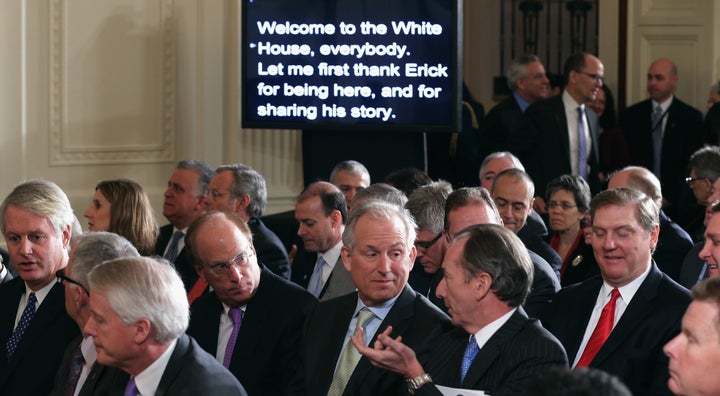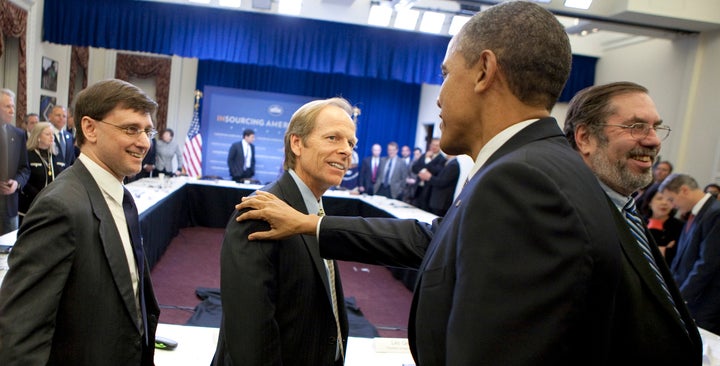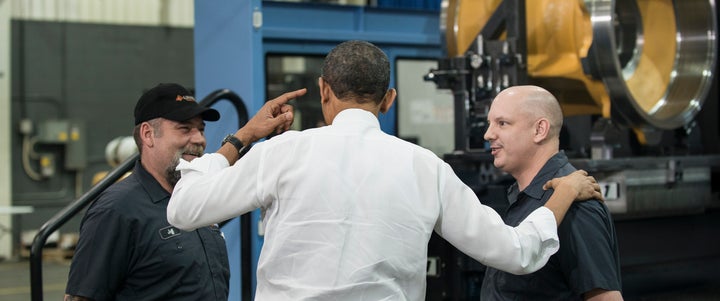This piece is part of a series on Obama’s legacy that The Huffington Post will be publishing over the next week.
WASHINGTON ― After President-elect Donald Trump successfully bullied a manufacturing firm into keeping a plant in the United States last November, some people wondered why President Barack Obama hadn’t similarly made an example out of a business or two and taken a stand for workers.
Actually, he had ― though in ways that exemplify the difference between ragey Trump and calm, consensus-loving Obama.
One example is how Obama approached the problem of prolonged joblessness, a signature economic challenge of the Obama era. The president frequently highlighted the suffering of laid-off workers, but some companies decided that they just didn’t want to hire the jobless. The phenomenon first cropped up in 2010 with job listings that specified applicants “must be currently employed.”
Democrats, including Obama, proposed outlawing such ads ― an idea that had no hope of garnering Republican support or becoming law. A ban on such discriminatory ads would have been ineffective anyway, since employers can easily screen the unemployed without being explicit about it.
So Obama used the White House megaphone.
“I’m challenging CEOs from some of America’s best companies to hire more Americans who’ve got what it takes to fill that job opening but have been laid off so long no one will give their résumé an honest look,” Obama said in a July 2013 speech.
Instead of calling out specific companies for their callous hiring practices, six months later Obama hosted a bunch of CEOs and a formerly unemployed worker at the White House. Several dozen executives signed a pledge saying they would commit to hiring unemployed people, or at least commit to not not hire them specifically because they’re unemployed. The pledge was nonbinding, its results difficult to verify.
The following October, the White House said one company, the telecom firm Frontier Communications, hired more than 250 unemployed people after signing the pledge. (The company declined to make any hirees available for an interview for this story.)
Obama’s symbolic effort to make companies hire the jobless may have been inconsequential ― which is, of course, the trouble with symbolic gestures.

Far more consequential was his effort to get a massive spending bill through Congress in the early days of his administration, which included money for unemployment benefits, infrastructure projects and tax cuts. Many, but not all, economists credit the stimulus for helping prevent a full-blown economic depression.
The economy turned around and unemployment fell in Obama’s first term, but there was still a significant problem. Many of the new jobs came in low-paying industries like retail and restaurants. From 2010 to 2013, the Federal Reserve Bank of New York reported this year, the national economy added far fewer middle-wage jobs than either high-paying or low-paying ones ― a “job polarization” scenario that further contributed to an already historic income inequality problem.
But from 2013 to 2015, the job polarization trend may have reversed. The Labor Department’s Heidi Shierholz wrote in a September blog post that there has been a “notable decline in the number of workers in very low-wage jobs,” which was “likely due to workers moving into a higher wage category rather than experiencing job loss.” When the Census Bureau reported that median household income had grown by more than 5 percent in 2015 ― a record annual growth rate ― White House economic adviser Jason Furman called it the best annual income report ever.
The current low unemployment rate, at 4.7 percent, masks some problems, most notably the fact that fewer working-age people are “participating” in the labor force by actively looking for jobs, probably because some believe decent work is not available. Low participation can push the overall jobless rate down, since people aren’t counted in the “unemployed” tally if they aren’t actively searching for work.
“We’re moving in the right direction,” said Elise Gould, an economist at the Economic Policy Institute, a liberal think tank that says there are more than 2 million such “missing workers.” “We’ve made huge amounts of progress. We’re just not there yet.”
Another problem is that long-term unemployment remains above normal. It’s an experience from which many Americans do not fully recover. Take, for example, Jeff Adams, 61, who spent two years unemployed after losing his defense procurement job in 2010. He wound up working as a home health aide, work that doesn’t require any higher education and typically pays poorly. It’s one of the fastest growing occupations in the U.S., thanks to an aging population.
Adams initially become a home health aide because that was the only kind of work he could find, but now such menial work is the only kind he wants. He also dealt with cancer while he was out of work, which further dampened his desire to pursue a high-stress career.
“If you’ve got your health and enough money to feed yourself, those are two things that are so important, and I realized time is the most important thing we have,” Adams said.
In December, he told HuffPost he was once again unemployed but planning either to return to home health care work, get a job in a home goods store or become an Uber driver. The percentage of workers in nontraditional gigs, like driving for Uber, has risen in recent years.
“Many people watching tonight can probably remember a time when finding a good job meant showing up at a nearby factory or a business downtown. Maybe you’d even have the pride of seeing your kids work at the same company.”
- President Barack Obama in his 2011 State of the Union address
The persistence of long-term joblessness has been an urgent, immediate crisis. Another problem for Obama has been an ongoing decline in decent jobs for people without a college education. He described the problem most vividly in his 2011 State of the Union address, when he said it used to be people could just show up at their dad’s factory right out of high school.
“Many people watching tonight can probably remember a time when finding a good job meant showing up at a nearby factory or a business downtown,” Obama said. “Maybe you’d even have the pride of seeing your kids work at the same company.”
About 8 percent of U.S. jobs are in manufacturing, and they’re more than symbolically important because they tend to pay higher wages than other jobs available to workers with little education. Less manufacturing means lower wages for everyone, since laid-off machinists and gauge setters wind up competing for the same jobs at Walmarts and Amazon warehouses.
Manufacturing employment had been on the decline in the U.S. well before Obama became president, due to increased automation and productivity. The steepest drop occurred right before he took office, thanks to the Great Recession, and one of Obama’s most significant responses was the auto bailout. The Center for Automotive Research estimated the special bankruptcy process for General Motors and Chrysler saved 1.5 million jobs, including thousands of factory positions.
In his 2012 State of the Union address, Obama said he wanted to see “an economy built on American manufacturing, American energy, skills for American workers and a renewal of American values.”
He also praised Master Lock, manufacturer of locks and other security devices, for shifting some production from overseas back to a highly automated plant in Milwaukee. He’d previously highlighted the company at an event at the White House with executives from several companies that had boosted production in the U.S. “You’ve heard of outsourcing. Well, these companies are insourcing,” Obama said.

In 2012, Obama pledged to create 1 million American manufacturing jobs by the end of 2016. Manufacturing employment has increased by about 315,000 jobs since then. Overall manufacturing employment remains below where it had been at the beginning of 2009.
Still, Scott Paul, president of the Alliance for American Manufacturing ― an advocacy group funded by steel companies and the United Steelworkers union ― said Obama’s symbolic focus on manufacturing deserves praise. Obama called low-skill factory jobs a relic, but Paul liked that the president did such things as holding a rally at a truck plant in 2013 and bringing a smattering of trade-enforcement cases against countries in the World Trade Organization.
“Obama’s approach was nuanced,” Paul said in an interview. “He very much viewed manufacturing as a special sector for various reasons.”

Like Obama, Trump has held up manufacturing as a symbol of lost greatness, but he has not been nuanced. Instead of saying the loss of some manufacturing jobs is inevitable and that workers must adapt, Trump said the opposite. Instead of praising specific companies for insourcing, he has attacked them for outsourcing.
“We’re going to bring our manufacturing back,” Trump said in July, singling out the heating-and-air-conditioning manufacturer Carrier. “We’re not going to let Carrier come in, make air conditioners in Mexico and sell them to us across a very strong border.”
Obama mocked Trump’s hectoring of Carrier and claims that he could stop the company from closing an Indianapolis furnace factory that employs 1,400 workers.
“He just says, ‘Well, I’m going to negotiate a better deal,’” Obama said in June. “How exactly are you going to negotiate that? What magic wand do you have?”
Trump wound up striking a deal with the company to keep 800 jobs in the U.S. instead of shifting all its production to Mexico; his magic wand may have been the massive amount of contracting Carrier’s parent company does with the federal government. Though it only affected one company, workers at other firms shifting production abroad have said they’re heartened by Trump’s symbolic victory with Carrier.
Don Zering said his dad got him a job at Rexnord Corp.’s ball bearings plant in Indianapolis ― about a mile from the Carrier factory ― four days after he graduated high school in 1973. He said he started as a janitor, then worked his way up to a machinist position that he’s held ever since. He’d originally planned to go to trade school, but the money was good.
“My dad raised our family, four people, he did that and I knew what it was like,” Zering said. “It was firm good work.”
Last year Rexnord announced plans to shut the plant down and shift production to Mexico, where its labor costs will be lower. Trump dissed Rexnord in a tweet, but the company doesn’t seem to care.
Zering said he didn’t vote for Trump, but he didn’t recall anything in particular Obama had done or said about manufacturing.
“I’m not blaming him one way or the other, but he didn’t make that call like Trump did,” Zering said.
